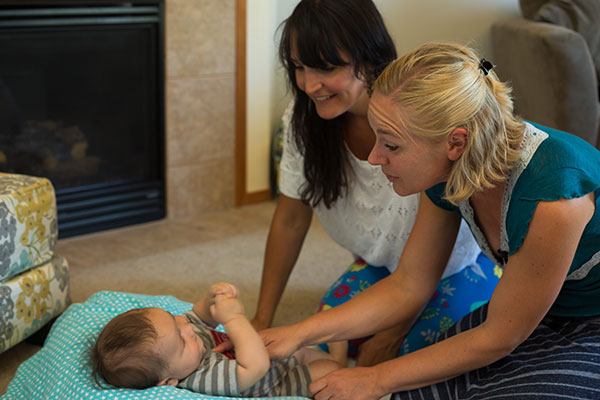 Introduction
Introduction
Developmental screening is a process involving partnerships with parents to identify concerns about a child's development. As many as one in four children under the age of 6 are at risk for a developmental delay or disability (Birth to Five, Watch Me Thrive!).
Screening alone is not enough to identify a developmental concern. Rather, it helps staff and parents decide whether to refer a child for more evaluation by a qualified professional. The earlier a possible delay is identified, the earlier a program can refer a child for further evaluation and additional supports and services.
Strategies
When the screening is finished, the results determine what programs and families do next. Programs create their developmental screening policies and procedures based on children and families served, screening tools, Health Services Advisory Committee recommendations, and other factors. See next steps under "Examples."
Developmental screening involves:
- Research-based, standardized developmental screening tools
- Information from family members, teachers, and other staff who know the child
- Written parental consent before starting the screening
- Communication with parents in their home language
Appropriate Screening Tools
When searching for screening tools, keep the following in mind.
- Screening tools must be research-based and designed to be a brief measure of development that identifies if the child needs more in-depth evaluation.
Screening tools should be:
Some skills may look different depending on the child's culture and background. Use a screening tool that considers the child's cultural context. When a culturally appropriate screening tool is not available, asking families about their child's typical behavior becomes even more critical. This information helps staff interpret screening results.
- Age appropriate
- Culturally appropriate
- Sensitive to the family's home language
- Used by trained and qualified personnel
- Valid for the intended results
- Reliable across users
- Clearly identified for use in screening
Programs need to make careful and informed decisions about whether to screen a child who is a dual language learner (DLL) in their home language, English, or both. For more information, see Special Considerations: Developmental Screening of Children Ages Birth to 5 Who Are Dual Language Learners (DLLs).
Timing
If there is a gap between enrollment and when the child starts, use the time to begin developing a relationship with the child and family to learn about the child. Then, conduct the screening as appropriate.
Programs must complete or receive a current developmental screening within 45 days of a child entering the program. If the program operates 90 days or less, the screening must be completed or received within 30 days. Entry into the program means the child has either:
- Started his or her first day in a Head Start or Early Head Start center or family child care setting
- Had his or her first home visit, if enrolled in the home-based option
Programs may keep track of a child's development with an annual screening. Also, a child and family's primary health care provider may do developmental screening, autism spectrum disorder screening, and developmental surveillance as part of the state's Early and Periodic Screening, Diagnostic, and Treatment (EPSDT) periodicity schedule. Ask parents to take their child's screening results to their primary health care provider and to share the results of their child's most recent well-child exam with you.
Pediatricians may have good relationships with a child and family. They may complete a developmental screening before the child's first day in the program.
Examples
These are examples of next steps a program might take based on the results of the screening.
- Results: There are no concerns.
Action: The child participates in ongoing, individualized care. Staff do ongoing child assessments. (See Ongoing Assessment for Children Ages Birth to Five for more information) - Results: The results are unclear or there may be additional concerns.
Action: The child participates in ongoing, individualized care. Staff do ongoing child assessments. Parents and staff closely observe the child's development over time to decide if they should re-screen or evaluate the child. - Results: The screening or information collected from family members, teachers, and other program staff found some concerns.
Action: The child participates in ongoing, individualized care. Program staff work with the parents to refer the child for a free evaluation. Infants and toddlers go to the appropriate Individuals with Disabilities Education Act (IDEA) Part C agency and preschool children go to the appropriate Part B agency, usually a school district. Parents may need support to navigate the referral and evaluation process.
 Head Start Program Performance Standards
Head Start Program Performance Standards
Child screenings and assessments, 45 CFR §1302.33:
- (a)(1)–(5) Screening
- (c)(1) Characteristics of screenings and assessments
- (d) Prohibitions on use of screening and assessment data
Parent and family engagement in education and child development services, 45 CFR §1302.34:
- (b)(6) Engaging parents and family members
Education in home-based programs, 45 CFR §1302.35:
- (f) Screening and assessments
Child health status and care, 45 CFR §1304.42:
- (c)(2) Ongoing care
- (d)(1)–(2) Extended follow-up care
- (a) and (b)
« Go to Head Start Tip Sheets for Grantee Planning
Read more:
Resource Type: Article
National Centers: Early Childhood Development, Teaching and Learning
Audience: Teachers and Caregivers
Last Updated: May 22, 2024